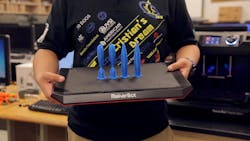3D Printing Education Closes the Skill Gap for Students and Employers
It’s 2018 and STEM skills power the global economy. The internet age hit outdated education models like a ton of bricks, and educators quickly learned to use all available tools to teach skills like coding and computer science. But the new digital economy isn’t all digital. Sure, students aren’t building spice racks in shop class anymore, but that doesn’t mean they’re not building physical things at all.
This is where modern makerspaces and 3D printing come into play—and where industry leaders should take notice. This is the perfect opportunity to instill career-ready STEM skills in students using 3D printing. Companies can’t afford to stand by and expect the perfect 21st-century workforce to just arrive at their doors, resumes in hand. In the same way that professionals reacted to the computer science skills gap and began pushing for greater computer and code literacy, it’s now time for companies to take proactive steps toward greater design and CAD literacy
Here are a few ways companies can get started.
Makerspaces and STEM Clubs
One of the easiest ways to teach career-ready skills in local communities is to give students access to 3D printers, whether through donations or grants. Even a single printer can serve an entire classroom or several after-school robotics and maker clubs. The raw futurism and capability of a 3D printer is uniquely inspiring to students, and even without the most structured curriculum, students never fail to surprise us with how quickly they pick up the technology and the innovative projects they embark on.
Creating early familiarity with professional tools is important, but exposure is only half the battle. Automaker Ford doesn’t want entry-level engineers who have only seen a 3D printer; they want talent that can walk on-site knowing as much CAD and 3D printing as possible. This is where support for programs, curriculum, and mentorship is important.
FIRST Robotics is a great example of this sort of program. In order to build a robot that meets a long list of specifications, the teams have to learn basic design and engineering principles, and basic CAD and electronics skills. With coaching from industry mentors in engineering and manufacturing, students graduate high school with serious technical backgrounds.
Design and Engineering Challenges
Competition is a great motivator for innovation, and free online CAD software like Tinkercad has made 3D design challenges completely accessible online. Any company looking to promote design and engineering skills in their field is only a few tweets away from kicking off a national challenge that can drive hundreds of entries. NASA and the Association of Mechanical Engineers (ASME) sponsor the annual Future Engineers challenge, which tasks students to design tools that can be 3D printed in space.
This year’s “Two for the Crew” challenge asks that students design a single tool that can be used for two unique tasks on the International Space Station, with the chosen design to be printed in space. NASA and ASME simultaneously inspire students to explore these 21st-century jobs while also imparting highly valued design and problem-solving skills.
Courses and Workshops
For decades, automotive and aerospace industries have recognized the importance of aligning higher education skill sets with their talent needs. Internships, fellowships, and corporate-sponsored scholarships help align student goals with future employer expectations and enable university graduates to enter competitive and technical jobs. But the digital economy is more than cars and planes. CAD and design skills are critical to industries across the board, and so is the need to communicate more directly with universities about their desires.
Tired of screening underqualified, new grads? Sponsor a course at a university that teaches exactly what you need. It’s easier than you think, and faculty are eager to collaborate with third parties that can validate their lessons and give powerful context to the skills they’re teaching. MakerBot and Autodesk are currently sponsoring a “paperless” industrial design course at Rochester Institute of Technology that challenges students to design and build products using only CAD and 3D printing.
In-House Vocational Training Programs
While fellowships and internships can provide general structure to vocational training, the ultimate training tool for companies is an in-house program. The most successful programs coordinate with universities, like Northeastern’s that requires every student to spend a “co-op” year working for a company relevant to their degree. Manufacturing leaders like Mercedes and Daimler have implemented their own in-house programs that include structured lessons and project learning, apprenticeships, and dedicated 3D printing and fabrication labs for students to learn the full range of modern tools their professional counterparts use.
And if budgets and resources allow, a regular summer internship program can lead to a more impactful vocational training program. The foundational assets you use to build out student training projects and facilities can advance your company’s workforce for years to come.
It’s clear that our educators mustn't bear all the responsibility of equipping students with modern skills for the digital economy. The fact is, 3D printing education isn’t only beneficial to individual students, but also to employers that depend on innovation to survive. If companies in the new economy want the talents to match their ambitions, it’s time they get personal and share those ambitions directly with students.
Forrest Leighton is vice president of marketing for MakerBot.
